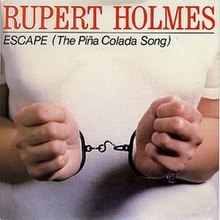Shifting from an adulterous predicament to a moment of sudden recognition in “Escape,” Rupert Holmes employs awkward irony, secretive paradox, and romantic imagery to express that though our normal lives may seem “like a worn out recording, of a favorite song,” the excitement we look elsewhere for may be hidden right before our eyes. Engaged in this song, secretive paradox plays a big role in getting Holmes’ message across. The story of the song is of a man’s boring life that “had fallen into the same old dull routine” and how he plans to escape. So, he “wrote to the paper” to meet his dream girl. When he gets there, it is paradoxically his “own lovely lady” who he wrote to. This paradox is set up to show that the speaker is tired of his “old lady” and had “been together too long” but in fact the perfect life they dreamed of and planned to escape to was with their significant other, the person they “never knew.” This helps depict that the excitement we look elsewhere for may be hidden right before our eyes because all the things they both claim to love lies in the person who they find “worn-out.”
In the song, awkward irony is operated by Holmes when his “own lovely lady” walks in the bar, despite this being his attempt to get rid of what he thought was their “old dull routine.” When they realized “‘Oh, it’s you,”’ they “laughed for a moment” because they realized that though they had expected to meet the person they would escape with, they met the person they had hoped to escape. To them, this person held a different meaning. Though they thought they were sick of them, the irony of the situation is that they didn’t know their own partner well enough to know that they had their escape lying right before their eyes.
Romantic imagery, also utilized by Holmes, is constant throughout the song, seen in the four letters written between the couple. The imagery is based upon senses that most people enjoy such as “Pina Coladas” and “making love at midnight, in the dunes of the cape” to help attract people closer to the song, making the message that much easier to see. Since the subject of the loss of the “spark” in love is used, imagery based upon romance helps to draw people close to the song who may have their own relationship issues. Although not directly connected to the message, the imagery used in this song emphasizes the message, and elucidates how little this couple searched for these simple, yet romantic, in their own partner before giving up and looking elsewhere. Through his use of secretive paradox, awkward irony, and romantic imagery in “Escape,” Holmes makes the speaker and his partner look almost stupid for not knowing these simple things about each other and therefore makes us further questions our own lives as to whether or not we have looked into everything as deep as we should have.

No comments:
Post a Comment